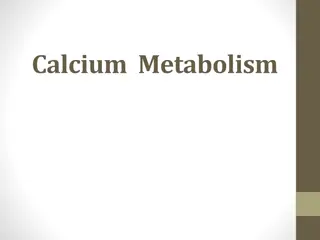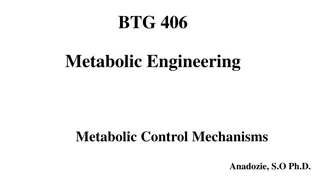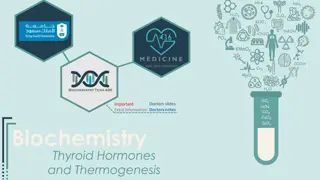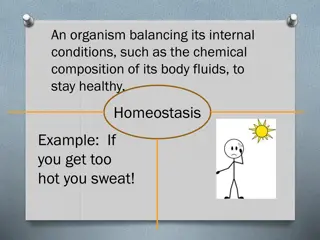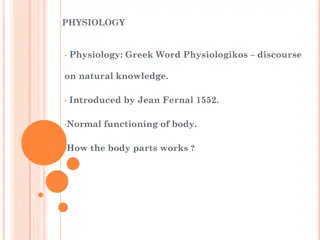
Homeostasis and Its Importance in Physiology
Explore the concept of homeostasis, its significance in maintaining a balanced internal environment in living organisms, and the physiological control mechanisms involved. Learn about feedback mechanisms, positive and negative feedback, and their impact on disturbances in extracellular fluid volume and osmolarity.
Download Presentation

Please find below an Image/Link to download the presentation.
The content on the website is provided AS IS for your information and personal use only. It may not be sold, licensed, or shared on other websites without obtaining consent from the author. If you encounter any issues during the download, it is possible that the publisher has removed the file from their server.
You are allowed to download the files provided on this website for personal or commercial use, subject to the condition that they are used lawfully. All files are the property of their respective owners.
The content on the website is provided AS IS for your information and personal use only. It may not be sold, licensed, or shared on other websites without obtaining consent from the author.
E N D
Presentation Transcript
Homeosta Homeostas sis is Dr. Maha Saja Physiology department, Level2, Office89, Extension # 56210 Email:msaja@ksu.edu.sa
Objecti Objectiv ves es Define and discuss the concept of homeostasis and its importance to the livingorganism. Discuss the physiologic control mechanisms that enable maintenance of the normal steady state of the body. Define a feedback mechanism and describe its components. Differentiate between positive and negative feedback mechanisms and give examples for each in the body. Apply the knowledge gained in feedback mechanisms to disturbances in the disturbances in ECF volume and osmolarity.
The The Internal Internal environment environment All body cells live in the same environment ECF. The skin separates this environment from the outside world (external environment). 3
In order for the cell to function properly, The internal environment need to have the right amount/level of these substances/variables. (not too much and not toolittle) waste CO2 Urea Work Energy(ATP) Chemical reactions enzymes Fatty acids Aminoacids pH Temperature Glucose Oxygen Ions ECF (Mr. Ford s class-Introduction to anatomy and physiology-youtube)
The The Internal Internal environment environment The internal environment must be kept constant in the face of an everchanging externalenvironment. The internal environment of the body (ECF)is in a dynamic state ofequilibrium 5
Homeostasis Homeostasis The process by which the body keeps the internal environment constant despite changes in the external environment is known as Homeostasis . Homeostasis means: Homeo- : sameness,similarity -stasis: standing Essentially all the functions of the bodyorgans and tissues aim at keeping the internal environment at a nearly constantstate. (Guyton and Hall Textbook of Medical Physiology. 13th ed.Ch-1)
Controlsystems Protection Skin Immunesystem Nervous system Endocrine systems O2 Internal environment CO2
Body constituents are normally regulated within a range rather thana fixedvalue;
Control Control Mechanisms Mechanisms The body has thousands of control systems. They function to restore balance when it is lost. Control systems operate; Within the organitself Throughout the body to control interrelations between organs. 10
Feedback Feedback Mechanisms Mechanisms What is meant by feedback? A loop system in which the system responds to perturbation either in the same direction (positive feedback) or in the opposite direction (negative feedback).
What What are feedback feedback mechanism? are the components of the components of a a mechanism?
The The Thermostat Thermostat Analogy Analogy
Types Types of of Feedback Feedback Mechanisms Mechanisms Negativefeedback Positivefeedback The effector response is in the same direction of the stimulus that initiated the response. The effector response of the system is in the opposite direction to the stimulus that initiated the response. E.g; In nerve signaling, entry of a small amount of Na+ into the cell will open more Na+ channels causing more Na+ to enter the cell. E.g; A high level of in CO2 in the ECF will increase pulmonary ventilation, increasing the amount of CO2 expired which will bring the level of CO2 in ECF down. Only few systems display positive feedback mechanisms..WHY? Most of the control systems of the body act by negative feedback. (Guyton and Hall Textbook of Medical Physiology. 13th ed.Ch-1)
Examples Examples of of Negative Negative Feedback Mechanisms Mechanisms Feedback Body temperaturecontrol
Examples Examples of of Positive Feedback Positive Feedback Mechanisms Mechanisms Childbirth Can you find other examples for a positive feedback mechanismin thebody?
Disease Disease is a is a state state od homeostasis homeostasis od disturbed disturbed
Body Body Fluid Fluid Imbalance Imbalance BodyFluid Imbalance Volume change Osmolarity change Commonlyboth occurtogether Volume expansion Volume contraction Hyper- osmolarity Hypo- osmolarity Decrease output (kidney failure, SIADH) Increase output (diarrhea, vomiting, diuretics) Loss of salts (diuretics) Excessive salt intake Gain of water more than solutes(SIADH) Loss of water more than solutes Increase input (Infusion of excessive IV fluids) Decrease input (lowintake)
What What are operating in Fluid balance operating in Fluid balance control? are the the feedback feedback mechanisms mechanisms control?




